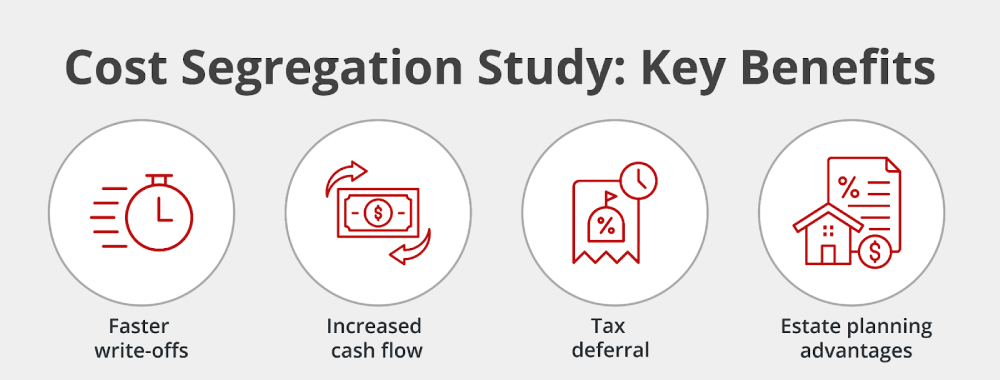Cost Segregation Study: What It Is & How It Works
KEY TAKEAWAYS
- Cost segregation studies help property owners reduce their tax burden by reclassifying building components for faster depreciation deductions.
- Investors typically see substantial tax reductions in the first few years after implementing a cost seg study.
- The upfront cost of the study often pays for itself within the first year through increased tax savings and improved cash flow.
- You can conduct lookback studies on properties purchased in previous years to capture missed depreciation benefits.



 Outstanding Client Experience
Outstanding Client Experience Specialized Lending Solutions
Specialized Lending Solutions Direct-to-Consumer Advantage
Direct-to-Consumer Advantage We're Advisors, NOT Salespeople
We're Advisors, NOT Salespeople Effortless Digital Mortgage Platform
Effortless Digital Mortgage PlatformReal estate investing comes with many benefits, but few tax strategies offer the immediate impact of a cost segregation study. This tax tool can significantly reduce your tax burden while improving cash flow from your investment properties. Understanding how cost segregation works could save you thousands of dollars each year. Keep reading to learn everything you need to know about cost segregation.

KEY TAKEAWAYS
- Cost segregation studies help property owners reduce their tax burden by reclassifying building components for faster depreciation deductions.
- Investors typically see substantial tax reductions in the first few years after implementing a cost seg study.
- The upfront cost of the study often pays for itself within the first year through increased tax savings and improved cash flow.
- You can conduct lookback studies on properties purchased in previous years to capture missed depreciation benefits.
What Is a Cost Segregation Study?
A cost segregation study is a tax tool that breaks down the various components of a commercial or residential investment property to accelerate depreciation deductions. Instead of depreciating the entire building over the standard timeline, this engineering-based analysis identifies specific elements that qualify for shorter depreciation periods.

Under normal circumstances, commercial real estate is depreciated over 39 years, while residential rental properties follow a 27.5-year schedule. This means you can only deduct a small fraction of the building’s cost each year. However, many components within these buildings — like carpeting, lighting fixtures, landscaping, HVAC equipment, plumbing, electrical, and other building systems— can actually be depreciated much faster.
So, what is cost segregation? It’s a way to unlock these hidden tax benefits that would otherwise remain buried in the standard depreciation schedule.
The study essentially separates personal property from real property, allowing investors to claim depreciation deductions in the early years of ownership. This approach contrasts with straight-line depreciation, where the same amount is deducted each year over the property’s entire useful life.
How Cost Segregation Works
The cost segregation process begins with a comprehensive engineering-based analysis of your property. Qualified professionals examine construction documents and architectural plans and conduct detailed property inspections to identify the components that can be reclassified for accelerated depreciation.
During the property inspection phase, engineers and tax specialists work together to catalog building elements based on their actual useful lives. They separate assets into different categories, including personal property with 5, 7, or 15-year depreciation schedules and real property that must be depreciated over 27.5 or 39 years.
Personal property typically includes items like removable fixtures, specialized lighting, carpeting, built-in furniture, and certain electrical components, among others. Land improvements such as sidewalks and landscaping often qualify for 15-year depreciation. Meanwhile, the building’s structural elements — like walls, foundation, and roof — are classified as real property with longer depreciation periods.
The reclassification process requires detailed documentation and must comply with IRS guidelines. Professional cost segregation providers use established methodologies to ensure the study meets tax code requirements while maximizing legitimate depreciation opportunities. This thorough approach protects property owners from potential IRS challenges while delivering substantial tax benefits.
With the recent legislative reinstatement of 100% bonus depreciation, property owners can now fully depreciate eligible 5, 7, and 15-year property in the first year of ownership or improvement. This change dramatically increases the upfront tax benefits of a cost segregation study and enhances real estate investment cash flow.
Under this rule, qualifying assets identified in a cost segregation study are immediately deductible, allowing investors to claim a much larger portion of their depreciation in year one instead of waiting over several years.
To illustrate how this works, consider a $2 million single-family rental home purchased by an investor. Under standard depreciation, the building would be depreciated over 27.5 years, allowing roughly $72,000 ($2,000,000 ÷ 27.5 years) in annual deductions.
However, with a cost segregation study and the availability of 100% bonus depreciation, let’s say $400,000 of the property’s components are identified as short-life assets:
- $200,000 in 5-year property (e.g., fixtures, flooring, and appliances),
- $100,000 in 7-year property (e.g., cabinetry and some site utilities), and
- $100,000 in 15-year land improvements (e.g., paving, fencing, and landscaping).
Thanks to 100% bonus depreciation, the entire $400,000 can now be deducted in full in the first year, a significant increase over the standard method. That’s an additional $400,000 in year-one depreciation, accelerating cash flow, and reducing taxable income.
Key Benefits of a Cost Segregation Study
The advantages of conducting a cost segregation analysis extend far beyond simple tax savings, though those benefits alone often justify the investment.

- Massive first-year tax deduction: With 100% bonus depreciation, qualifying assets can be fully deducted in year one, dramatically reducing your current tax liability and delivering powerful upfront savings.
- Improved cash flow: Lower tax payments mean more money stays in your pocket, providing additional capital for property improvements, debt service, or new investments.
- Strategic tax planning flexibility: Cost segregation pairs with 100% bonus depreciation to immediately deduct qualifying 5, 7, and 15-year components in the first year, unlocking powerful upfront tax savings and aligning with your overall tax strategy. Years 2 through 27.5 will have straight-line depreciation of the remaining building basis (usually 60–80% of total value, depending on the segregation study).
- Estate planning advantages: The accelerated depreciation can help reduce the property’s adjusted basis, potentially minimizing estate tax exposure while maximizing wealth transfer opportunities.
- Reinvestment opportunities: The additional cash flow from tax savings can be reinvested into more real estate investments, accelerating portfolio growth and wealth building.
Enhanced return on investment: The immediate tax savings typically exceed the cost of the study within the first year, creating a strong ROI that continues throughout the accelerated depreciation period.
Who Should Consider a Cost Segregation Study?
Cost segregation studies aren’t right for every property owner, but they can be valuable in the right situations. The ideal candidates typically fall into several categories that maximize the potential benefits, including:
- Owners of newly purchased properties: Property owners who have recently acquired buildings usually see the greatest advantages since the depreciation benefits apply from the property’s placed-in-service date.
- Construction and renovation investors: Those who have constructed new buildings or completed significant renovations can benefit from reclassifying newly installed components.
- High-value property owners: Real estate professionals and business owners with properties valued over $500,000 generally find that the benefits outweigh the costs of the study.
- Investors with substantial taxable income: Property owners with significant taxable income can immediately benefit from the increased deductions, while those with lower income levels might want to consider timing strategies.
When to Conduct a Cost Segregation Study
Timing your study right maximizes the benefits of your cost segregation study. The most advantageous time is immediately after property acquisition, construction completion, or substantial renovation work. Starting the study process early ensures you capture the maximum depreciation benefits from the beginning of your ownership period.
You should coordinate with your tax professional and cost segregation engineer before finalizing a property transaction so that the study can be completed and implemented with your first tax return. Early planning also ensures proper documentation is maintained throughout the construction or acquisition process.
Lookback studies also provide an opportunity you shouldn’t overlook. These studies can be conducted on properties purchased or improved in previous years, potentially unlocking significant prior-year tax savings. The IRS lets you “catch up” on missed depreciation through Form 3115.
Even delayed studies can provide substantial benefits, especially when combined with current-year property improvements or when preparing for major portfolio changes. However, it’s important to work with qualified professionals who understand the technical requirements and the strategic timing considerations of cost segregation studies.
Expand Your Real Estate Investment Portfolio

Real estate offers some of the most attractive investment opportunities available today, especially when combined with sophisticated tax strategies like cost segregation studies. The additional cash flow generated from accelerated depreciation can fuel your next acquisition, helping you build wealth faster through strategic property accumulation.
Griffin Funding helps investors maximize their real estate potential through competitive investment property loans and comprehensive financing solutions. Our team understands how tax strategies impact investment decisions and can structure loans that complement your cost segregation planning. Whether you’re expanding your portfolio or refinancing existing properties, we’re here to support your long-term success.
Get started online today and secure the financing needed to start or expand your real estate investment portfolio. You can also download the Griffin Gold app to explore your options and take the next steps in building your real estate empire.
Find the best loan for you. Reach out today!
Get StartedFrequently Asked Questions
Why do real estate investors use cost segregation? 
Real estate investors use cost segregation studies to unlock immediate, substantial tax deductions by identifying building components that qualify for accelerated depreciation. Thanks to the return of 100% bonus depreciation, many of these components—such as certain fixtures, appliances, and land improvements—can now be fully deducted in the first year of ownership.
Instead of depreciating the entire property over 27.5 or 39 years, investors can use cost segregation to separate out short-life assets and apply bonus depreciation, resulting in a massive first-year write-off. This strategy significantly reduces current tax liability, improves cash flow, and frees up capital to reinvest into property improvements or additional real estate acquisitions.
Are cost segregation studies worth it? 
Cost segregation studies are typically worth the investment for properties valued over $500,000, especially when conducted on recently purchased, constructed, or renovated buildings. The upfront cost of the study usually pays for itself within the first year through increased tax savings. The long-term benefits often far exceed the initial expense, making it a valuable strategy for most qualifying property owners with sufficient taxable income.
What is the downside of cost segregation? 
The main downsides of cost segregation include upfront study costs, increased complexity in tax reporting, and potential depreciation recapture when selling the property. Additionally, the accelerated depreciation reduces the property's adjusted basis, which may lead to higher capital gains taxes when you sell the property.
Property owners should also be aware that property taxes may vary by state, and some jurisdictions have different rules regarding cost segregation benefits. Working with qualified professionals helps minimize these risks while maximizing the overall benefits.
Recent Posts
Net Operating Income: Definition, Formula, & Examples
What Is Net Operating Income (NOI)? Net operating income measures how much money your investment property gene...
Best DSCR Lenders: Griffin Funding vs Angel Oak vs Kiavi vs Visio vs Lima One vs Easy Street
What to Look for in a DSCR Lender Choosing the best DSCR lender for your unique situation means evaluating sev...
Cash on Cash Return in Real Estate: Definition, Formula, & Examples
What Is Cash on Cash Return? Cash on cash return (CoC) is a metric that measures the annual income you generat...









